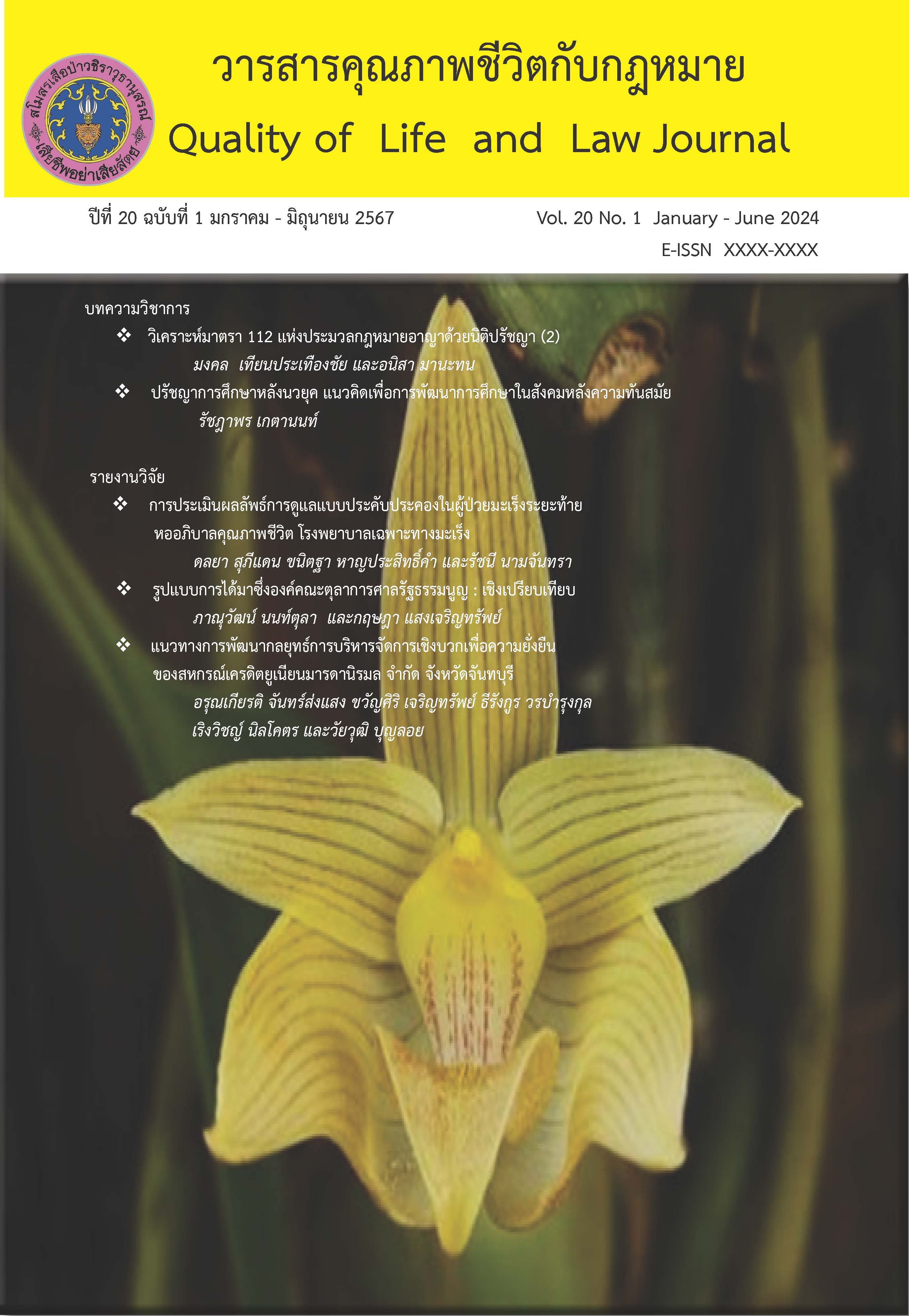Outcomes evaluation of palliative care for end-stage cancer patients at Quality of Life Care Unit, a Specialty Cancer Hospital
Main Article Content
Abstract
This retrospective descriptive study aimed to evaluate palliative care outcomes for
end-stage cancer patients. Fifty-six medical records of end-stage cancer patients admitted at the Quality of Life Care Unit, a Specialty Cancer Hospital, from January to June 2022 were assessed. The FACT-G and ESAS were used to evaluate patients’ quality of life and symptom burden, respectively. Data were followed at 5 times points; the admission date (T1), the discharge date (T2), 1 week (T3), 1 month (T4), and 3 months after discharge (T5). Data analysis involved descriptive statistics, repeated measures ANOVA, Friedman test, and Wilcoxon Signed Rank test.
The results revealed that end-stage cancer patients’ quality of life at T2, T3, T4, and T5 were higher than at T1, with statistically significant (p<.05). Moreover, symptoms of burden including; pain, tiredness, anxiety, drowsiness, lack of appetite, and worst well-being at T2, T3, T4, and T5 were lower than at T1, with statistical significance (p < .05). However, nausea, depression, and dyspnea did not show significant differences (p>.05) at any time point of assessment.
The results from this study suggest that a Quality of Life Care Unit for end-stage cancer patients promotes patients’ quality of life and decreases symptoms burden, especially pain and anxiety. Therefore, the Quality of Life Care Unit should develop a quality of care to manage symptoms burden for patients to maintain their quality of life at the hospital and at home.
Article Details

This work is licensed under a Creative Commons Attribution-NonCommercial-NoDerivatives 4.0 International License.
- บทความหรือข้อคิดเห็นใดๆ ในวารสารคุณภาพชีวิตกับกฎหมายเป็
- กองบรรณาธิการไม่สงวนสิทธิ์
References
กองยุทธศาสตร์และแผนงาน สำนักงานปลัดกระทรวงสาธารณสุข. (2564). สถิติสาธารณสุข พ.ศ.2564. https://www.spd.moph.go.th.
เจษฎาภรณ์ อิกำเหนิด จินดารัตน์ ชัยอาจ และวราวรรณ อุดมความสุข. (2563). การลดภาระของผู้ดูแลผู้ป่วยโรคมะเร็ง: การทบทวนอย่างเป็นระบบ. พยาบาลสาร, 47(1), 164-174.
นภา ทวียรรยงกุล สุชิรา ชัยวิบูลย์ธรรม และบัวหลวง สำแดงฤทธิ์. (2558). ประสบการณ์อาการและการจัดการในผู้ป่วยมะเร็งระยะลุกลามที่ได้รับการดูแลแบบประคับประคอง. รามาธิบดีพยาบาลสาร, 21(1), 82-95.
นภาพร ตั้งพูลผลวนิชย์ นาถฤดี สุลีสถิระ และสุณิสา ชื่นตา. (2563). การพัฒนาระบบการดูแลแบบประคับประคองในผู้ป่วยระยะสุดท้าย โรงพยาบาลยโสธร. วารสารสุขภาพและสิ่งแวดล้อมศึกษา, 5(2), 36-45.
ภิญโญ อุทธิยา ขวัญใจ อำนาจสัตย์ซื่อ พัชราภรณ์ เกิดมงคล และพิชัย จันทร์ศรีวงศ์. (2561). ผลของโปรแกรมการจัดการรายกรณีผู้ป่วยสูงอายุโรคมะเร็งระยะสุดท้ายในชุมชน. วารสารสารณสุขศาสตร์, 48(3), 371-384.
มัณฑนา จิระกังวาน และศิริรัตน์ จันตรี. (2561). การพัฒนาการดูแลแบบประคับประคองผู้ป่วยมะเร็งระยะท้ายแบบบูรณาการไร้รอยต่อโรงพยาบาลศรีสะเกษ. วารสารการพยาบาลการสาธารสุขและการศึกษา, 19(2), 70-83.
วาสนา สวัสดีนฤนาท อมรพันธุ์ ธานีรัตน์ และธารทิพย์ วิเศษธาร. (2558). การพัฒนารูปแบบการดูแลผู้ป่วยมะเร็งระยะท้ายแบบประคับประคองโรงพยาบาลมหาราชนครศรีธรรมราช, วารสารพยาบาลกระทรวงสาธารณสุข, 25(1), 144-156.
สุกัญญา วิริยโกศล และกัญญ์ธีรา วงษ์สุวรรณ. (2560). ผลลัพธ์การพัฒนารูปแบบการดูแลผู้ป่วยโรคมะเร็งระยะสุดท้ายแบบประคับประคองจากโรงพยาบาลสู่เครือข่ายชุมชน อำเภอกระทุ่มแบน จังหวัดสมุทรสาคร.วารสารวิชาการสาธารณสุข, 26(4), 759-769.
สุณัฏดา คเชนทร์ชัย และมุจจรินทร์ อัศวพัฒน์. (2564). การพัฒนาระบบการดูแลผู้ป่วยระยะท้ายเพื่อการดูแลต่อเนื่องที่บ้านในผู้ป่วยนอก. วารสารวิชาการกรมสนับสนุนบริการสุขภาพ, 17(3), 27-36.
สุนิดา เที่ยงแก้ว และประทีป สุขีลักษณ์. (2561). ผลลัพธ์การดูแลผู้ป่วยมะเร็งแบบประคับประคองในโรงพยาบาลมหาราช จังหวัดพระนครศรีอยุธยา. วารสารสมาคมเวชศาสตร์ป้องกันแห่งประเทศไทย, 8(1), 88-96.
สุพัตรา คงปลอด นิตยาศักดิ์ สุภา และทิวา เกียรติปานอภิกุล. (2565). ผลลัพธ์ของการดูแลแบบประคับประคองตามการรับรู้ของผู้ป่วยโรคมะเร็งและญาติผู้ดูแลโรงพยาบาลเจริญกรุงประชารักษ์. วารสารโรงพยาบาลเจริญกรุงประชารักษ์, 18(1), 69-85.
สมประสงค์ นักขัตระ. (2564). การศึกษาความชุกของอาการปวดและผลการพัฒนาระบบการดูแลผู้ป่วยมะเร็งระยะท้ายแบบประคับประคองที่บ้านในเครือข่ายหน่วยระบบบริการปฐมภูมิโรงพยาบาลสระบุรี. วารสารระบบบริการปฐมภูมิและเวชศาสตร์ครอบครัว, 4(2), 182-191.
Bausewein, C., Daveson, A., Currow, C., Downing, J., Deliens, L., Radbruch, L., Defilippi, K., Ferrrira, L., Costantini, M., Harding, C., & Higginson, J. (2016). EAPC White Paper on outcome measurement in palliative care: Improving practice, attaining outcomes and delivering quality services–Recommendations from the European Association for Palliative Care (EAPC) Task Force on Outcome Measurement. Palliative medicine, 30(1), 6-22.
Dionne-Odom, N., Azuero, A., Lyons, D., Hull, G., Tosteson, T., Li, Z., Li, Z., Frost, J., Dragnev, H., Akyar, I., Hegel, T., & Bakitas, A. (2015). Benefits of early versus delayed palliative care to informal family caregivers of patients with advanced cancer: outcomes from the ENABLE III randomized controlled trial. Journal of Clinical Oncology, 33(13), 1446-52. doi: 10.1200/ JCO.2014.58.7824.
Dyar, S., Lesperance, M., Shannon, R., Sloan, J., & Colon-Otero, G. (2012). A nurse practitioner directed intervention improves the quality of life of patients with metastatic cancer: results of a randomized pilot study. Journal of Palliative Medicine, 15(8), 890–95. doi: 10.1089/jpm.2012.0014.
International Association for Hospice & Palliative Care (IAHPC). (2019). Palliative care definition. [Internet]. [cited 2022 July 1]. Available from: Consensus-Based Definition of Palliative Care (2019) - International Association for Hospice & Palliative Care (hospice care.com).
Lavdaniti, M., Fradelos, C., Troxoutsou, K., Zioga, E., Mitsi, D., Alikari, V., & Zyga, S. (2018). Symptoms in advanced cancer patients in a Greek hospital: a descriptive study. Asian Pacific Journal of Cancer Prevention, 19(4), 1047-52. doi: 10.22034/APJCP.2018.19.4.1047.
McCorkle, R., Jeon, S., Ercolano, E., Lazenby, M., Reid, A., Davies, M., Viveiros, D., & Gettinger, S. (2015). An Advanced Practice Nurse Coordinated Multidisciplinary Intervention for Patients with Late-Stage Cancer: A Cluster Randomized Trial. Journal of Palliative Medicine, 18(11), 962–69. doi: 10.1089/ jpm.2015.0113.
World Health Organization. (2021). Global Cancer Observatory. [Internet]. [cited 2022 July 1]. Available from: https://gco.iarc.fr.
Yang, L., Liu, L., Wang, X., Wang, Y., & Wang, L. (2014). Prevalence and associated positive psychological variables of depression and anxiety among Chinese cervical cancer patients: a cross-sectional study. PloS one, 9(4), 94804.


